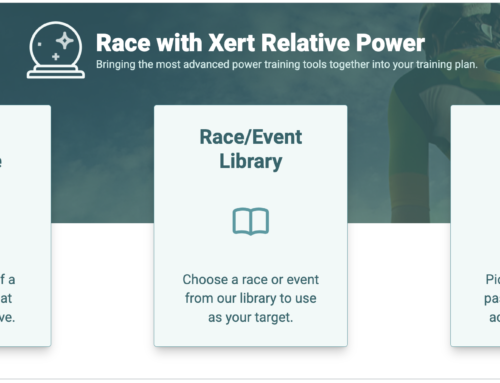From Zones to Strain & Focus
Training zones, whether based on heart rate or power, have long been a staple in prescribing workouts. These zones are typically defined relative to an athlete’s Functional Threshold Power (FTP) and can range from 3 to 9 zones or more. The idea is simple: by calculating the time spent in each zone, athletes can infer how much they’ve trained different aspects of their fitness.
For example, here is a 7-level set of training zones defined relative to FTP:
| Zone / Level | Name | %FTP |
| 1 | Active Recovery | < 55 % |
| 2 | Endurance | 56-75 % |
| 3 | Tempo | 76-90 % |
| 4 | Threshold | 91-105 % |
| 5 | VO2 Max | 106-120 % |
| 6 | Anaerobic Capacity | >121 % |
| 7 | Neuromuscular Power |
N/A |
However, while this method has its merits, it overlooks critical details like Maximal Power Available (MPA), Fitness Signatures, and Work Allocation Ratios. Let’s explore how Xert’s approach provides a more comprehensive view.
Our Example Athletes: Andre and Clara
Andre is new to training with power. Physically, Andre is gifted with good top-end power but views his endurance as a weakness. His Xert Fitness Signature is 1200 W, 26.0 kJ and 250 W for Peak Power, High Intensity Energy and Threshold Power respectively. He would like to focus his training on improving his Threshold Power but would like to also compete as a road-racer in the future.
Clara is a very competitive triathlete. She’s competed in Sprint and Olympic triathlons. Her Xert Fitness Signature is 800 W, 15.0 kJ and 300 W for Peak Power, High Intensity Energy and Threshold Power respectively. Her coach often prescribes Zone 4 “threshold” workouts but will schedule some Zone 5 workouts when she’s preparing for a Sprint triathlon. This helps her focus her training on her Threshold Power mostly but also prepare for the added intensity needed above Threshold Power during shorter triathlons.
A Sample Zone 4 and 5 Interval Workout
Consider a workout with the following zones based on %FTP (TP in Xert):
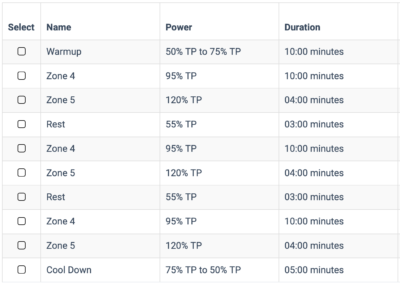
The overall workout is 63:00 in duration:
- 21 minutes is in Zones 1 & 2
- 30 minutes is in Zone 4
- 12 minutes is in Zone 5
Andre’s corresponding Workout MPA Chart is:

The chart above is from Xert’s Workout Designer. It shows the power intervals in multicoloured lines and shows Maximal Power Available (MPA) in magenta. MPA provides a measure of how much power Andre has at any given moment. When MPA gets close to the power line, it means that the workout becomes more difficult to complete. The workout designer also shows the difficulty score in the hatched black & white line.
For Andre, the workout’s MPA chart shows power intervals and tracks how close MPA comes to his power output, reflecting workout difficulty. Despite no significant drop in MPA, Andre’s Xert Strain Score (XSS) is 118 in 63 minutes, reflecting a challenging session for his fitness level. The Focus Type, which is based on the work allocation ratios, is Endurance, which translates to having a Focus of ~15:00 minute power. His weighted average power for the workout is 239W (not shown).
How a Small Variation Changes the Workout
Now, what if we reverse the Zone 4 and Zone 5 intervals?
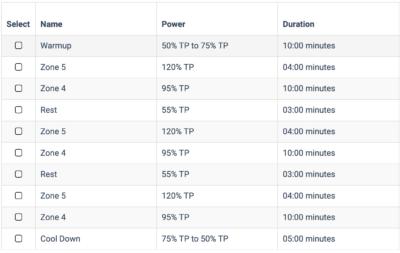
Time-in-zones is identical to the previous workout. Andre’s new Workout MPA Chart is now:
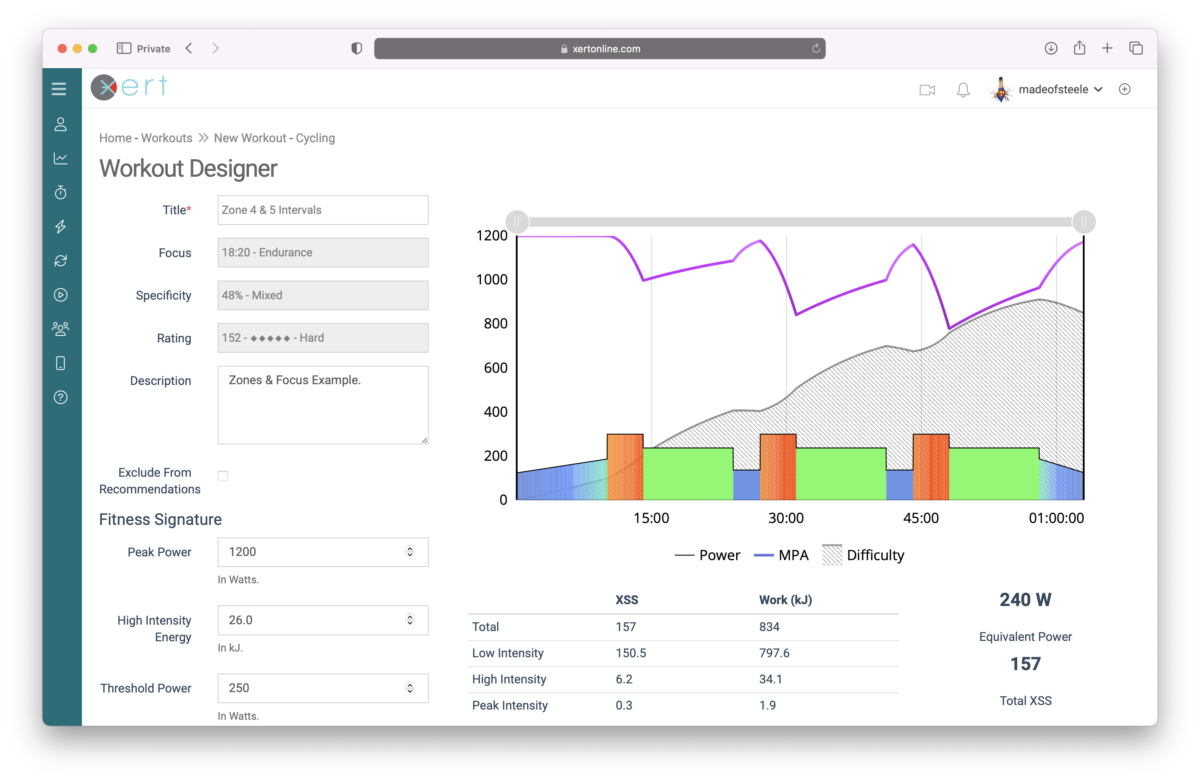
The total work performed for the workout remains the same at 834 kJ. The Normalized Average Power is also essentially unchanged rising only 0.2 W. However, the Xert Strain Score increases by 33% to 157 XSS. This is because doing the Zone 5 interval first causes significant fatigue, which lowers MPA, and then Andre must do the next 10 minutes in a fatigued state just below his Threshold Power. This is a much more difficult workout to complete – the difficulty score significantly higher (152 vs 114). In this case, Focus also remains relatively unchanged, so the primary benefit is still around ~15 min power.
When MPA is accounted for in a workout, the order in which the work performed in zones matters. Looking at the workout only through the lens of time-in-zones, weighted average power and total work miss this important information.
Clara’s Experience with Workouts
Using the identically defined workouts, let’s see how Clara would fare in her execution. The first Workout MPA Chart is here:
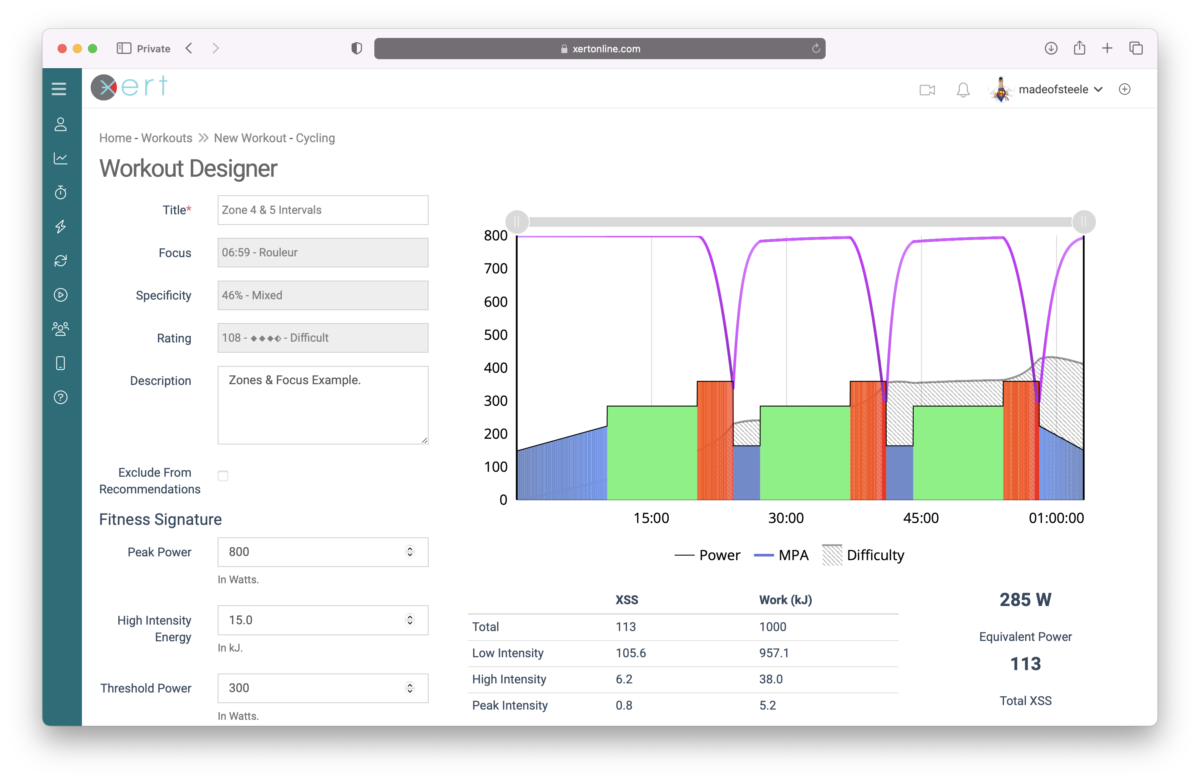
The %TP targets and interval durations are identical to Andre’s, and time-in-zones are exactly the same too. The total work of 1000 kJ is higher than Andre’s because her Threshold Power is higher. However, Clara is going to have a very difficult time completing this workout – you can see at the end of each Z5 interval that MPA comes very close to her power output. Despite using the same %TP targets, Clara’s Focus is also changed as a result of her different Fitness Signature. This workout is classified as a Rouleur (6:00 minute power) vs. Andre’s that was classified at Endurance (~15:00 minute power). This demonstration shows that even though time-in-zones and %TP targets are exactly identical, radically different results can occur depending on each athlete’s specific fitness values, even with relatively minor differences.
Further, if Clara’s coach reverses the intervals, the workout becomes nearly impossible due to the mismatch between her fitness level and the workout’s intensity, demonstrating how slight adjustments affect performance. Here is Clara’s Workout MPA Chart when the Z4 & Z5 intervals are inverted:
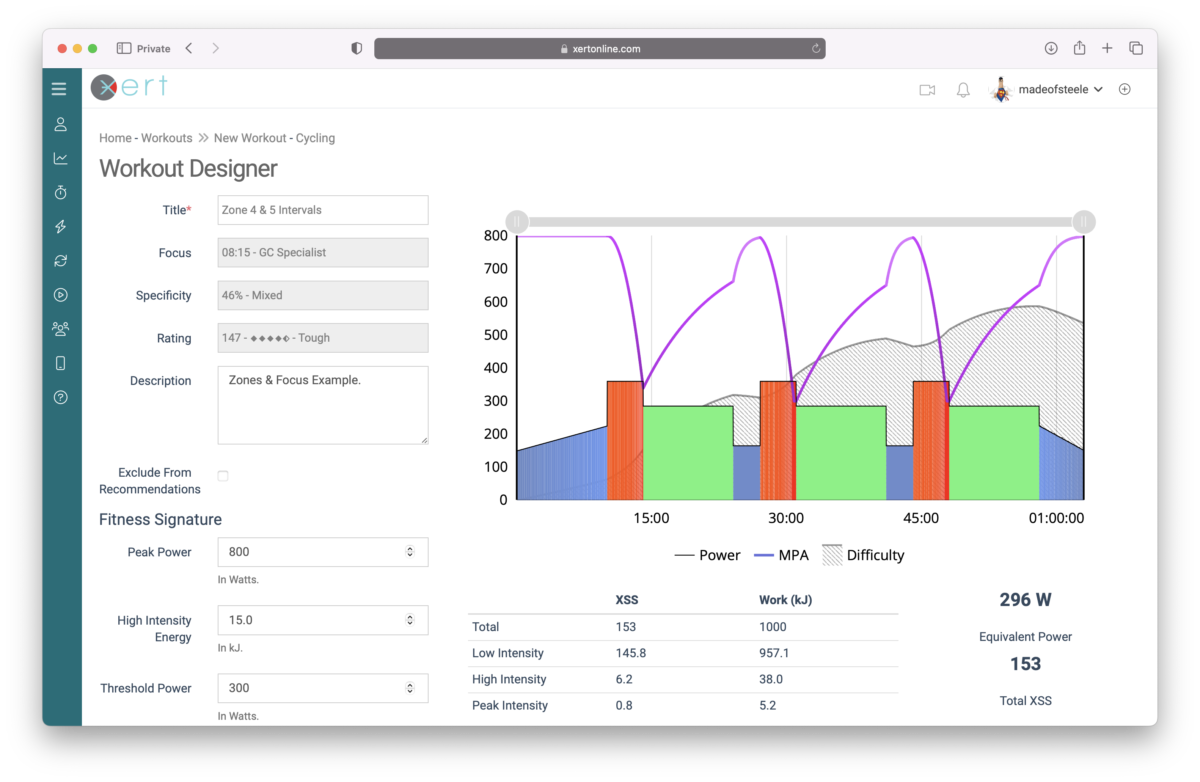
This workout would be virtually impossible to complete! Each Z5 effort would bring Clara nearly to failure before asking her to continue for 10 min just below Threshold Power. With 153 XSS in less than an hour, this might be one of the most difficult workouts Clara would have ever attempted. However, many metrics that other platforms might use, such as Weighted Average Power, Time in Zones, and Stress Score values are identical to the previous workout.
It’s important to note that Stress Scores calculated based on a Weighted Average Power and the total time-in-zones are exactly the same for all four workouts for both athletes.
With Xert, we now have an entirely new way to look at our workouts. By examining MPA and calculating the Xert Strain Score, we can know in advance the potential implications our unique fitness abilities have on our ability to execute the workout. We can also anticipate the dramatic effects of making changes will have, perhaps subtle ones, even if our traditional markers we have used are unchanged. This helps you train better, more efficiently, avoids attempting workouts that are too difficult, and helps you prevent potential over-training.
Training Smarter with Xert Workouts
Using Xert, workouts are designed to account for the unique differences between individuals. Workouts that are too hard or too easy can be identified in advance. This ability to tune a workout for a given athlete has traditionally been reserved for experienced coaches that spend a great deal of time getting to know their athletes so that they can customize workouts based on the athlete’s ability. With Xert, much of the guesswork is eliminated and athletes can perform workouts that are not only achievable, but are highly-tuned to them.
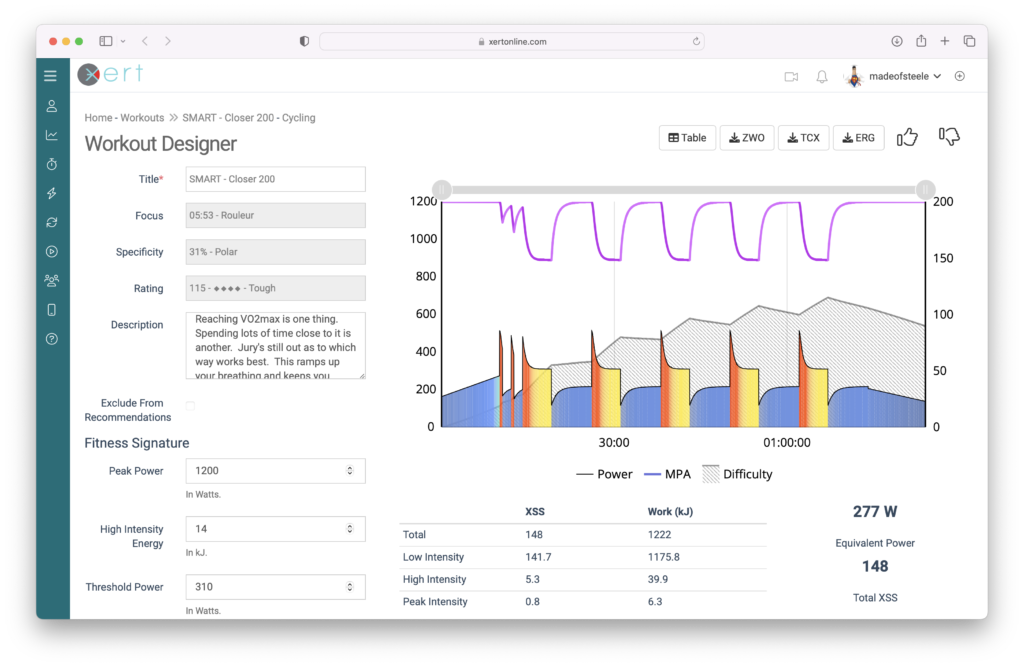
SMART Intervals enable the athlete to achieve very precise workout goals, increasing the training dose and specificity whilst still enabling the workouts to be achieved without ever reaching a point-of-failure. The unique workouts are more natural as the power targets follow the same course of fatigue. The workouts “feel” better and they provide the ability to generate more strain yet avoid bringing you to the point where you wish to give up.
Are your workouts too hard? Read more, here.
Keeping Things Simple with Focus Durations
One of the key advantages of working with a coach is their ability to adjust training zones based on an athlete’s unique needs. Instead of relying on pre-defined zones, coaches can use levels that are descriptive, not prescriptive. This allows the training to be more personalized, accommodating the differences between individuals. However, adjusting the boundaries of these levels adds complexity, as the demarcation points need to be continuously updated to reflect each athlete’s fitness.
This also means coaches may need to create multiple versions of a single workout to suit different athletes. For example, some athletes may need to perform their 4 x 8-minute intervals at 112%, while others may be able to handle 120%, and so on.
Focus Duration simplifies this process by removing the need for constant adjustments. Instead of dealing with changing zone boundaries, Focus Durations remain fixed, providing a prescriptive and easy-to-apply metric that eliminates an unnecessary layer of complexity.
Furthermore, Focus Durations are based on work allocation ratios for each of the three primary fitness systems—Low, High, and Peak Intensities. These ratios track the exact amount of work done in each intensity zone, down to every individual joule of energy expended. This means there’s no need to track time spent in each zone. Focus Duration condenses all that data into one number that reflects the total accumulated work across all intensity levels. This can be calculated from every second of a workout all the way through to an entire season. Focus Duration offers a straightforward and powerful way to measure the focus of your training, ensuring you can see where your efforts are concentrated.
Summary
Using Focus and Strain represents a significant paradigm shift in training. For those accustomed to zone-based training, it may take some time to adjust to this new approach. The shift can be particularly challenging for coaches, as familiarity with zones plays a large role in designing effective training programs.
Experienced coaches understand the limitations of traditional zone-based systems and are adept at avoiding common pitfalls. This is where their expertise becomes invaluable. Coaches use their knowledge to tailor training to each athlete’s specific needs, ensuring workouts are appropriately challenging and effective.
With Xert’s SMART Intervals and Focus & Xert Strain Score metrics, athletes and coaches can move beyond outdated zone methods. These new metrics allow for more accurate and personalized training, focusing on the overall strain and the precise focus of each workout. By adopting this data-driven approach, athletes can optimize their training programs for better results, and take their performance to new levels!


